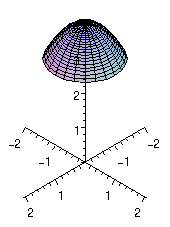
figure 1: the surface
This explanation is trying to get out the presence (or lack) of a scaling factor (e.g., the r in the polar coordinates area element dA = r dr dtheta) when we parameterize a surface to integrate over it. We'll use the same surface as in the divergence theorem example page. Which doesn't matter for the purposes of the calculation here, of course.

The Problem: write the surface integral of a function f(x,y,z) over the surface shown to the right. It's given by z = 4 - x2 - y2, for z >= 3.
A First Parameterization: We can parameterize this by thinking about cylindrical coordinates. The vector giving the surface is r = <x, y, z> = <x, y, 4 - x2 - y2>. In cylindrical coordinates, x = r cos(theta) and y = r sin(theta), so the surface is parameterized by
What are the limits on r and theta? We want z >= 3, so 4 - r2 >= 3, and r <= 1. We want to get the complete circle, so 0 <= theta <= 2pi.
Then we can find the surface area element dS = | rr x rtheta| dr dtheta by calculating the partials of r and taking the cross product. Check this on your own; the result should be
So dS = sqrt( 4 r4 (cos2(theta) + sin2(theta)) + r2 ) dr dtheta, and we can write the surface integral as
Why isn't there an extra factor of r? Because we didn't convert from rectangular to cylindrical coordinates -- here the scaling factor is the factor of sqrt( 4 r4 + r2 ), which serves to scale from the r theta world to the world on the surface S. (In other words, it gives the amount the little element dr dtheta is stretched as it gets moved up onto the surface S.)
Also note: because we're interested in the value of the function f on the surface, we evaluate it on r: f(r cos(theta), r sin(theta), 4 - r2).
A Second Parameterization: we can also formulate this problem using a "parameterization" in x and y. Then we have
with -1 <= x <= 1 and -sqrt(1 - x2) <= y <= sqrt(1 - x2).
Then we can calculate dS the same way we did above: dS = | rx x ry | dx dy, which comes out to (check that you get the same thing) dS = sqrt(4 x2 + 4 y2 + 1) dx dy.
Then we can formulate our flux integral as before:
Here the scaling factor is sqrt( 4 x2 + 4 y2 + 1) which gives us the scaling to get from the x y world (which is the projection of the surface onto the x y-plane) to the world on the surface S.
Now, suppose that we converted this integral to polar coordinates. Then x = r cos(theta) and y = r sin(theta), and dy dx = r dtheta dr, so that the integral becomes

And the two formulations are in fact the same!
Note what happened here: the factor of r that shows up when we convert from dx dy to dr dtheta is the scaling factor for how the area element stretches as we move between the x y and r theta worlds. This is analagous to the factors that represent the stretching as we move from x y (or, more generally, u v) to the world on the surface.
It is worth noting that in section 16.6 of the book, the surface area element is derived in somewhat less generality. There, the surface area element for a surface z = f(x,y) is found to be
Let's compare this with what we did. If z = f(x,y), then r(x,y) = <x, y, f(x,y)>, and
(Check that you can duplicate all of those steps!) Then in our case f(x,y) = 4 - x2 - y2, so
which is the same as we got before.
In general we won't memorize this special case, and will instead use the formulation in terms of the cross product of the partial derivatives of r.